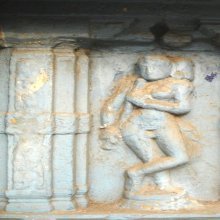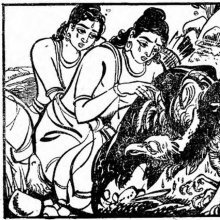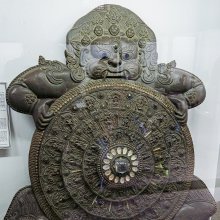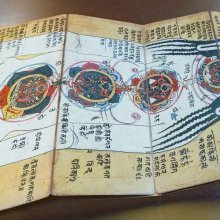Breath: 1 definition
Introduction:
Breath means something in Hinduism, Sanskrit. If you want to know the exact meaning, history, etymology or English translation of this term then check out the descriptions on this page. Add your comment or reference to a book if you want to contribute to this summary article.
Images (photo gallery)
In Hinduism
Yoga (school of philosophy)
Source: ORA: Amanaska (king of all yogas): A Critical Edition and Annotated Translation by Jason Birch1) The Breath is known in Sanskrit as Pavana, and is various Yogic exercises, according to the Dattātreyayogaśāstra verse 35-38ab.—Accordingly, while describing the lotus pose (padmāsana): “[...] Having lifted the uvula with the tongue; having fixed the chin on the chest and having drawn in the breath (pavana) slowly according to his capacity, he should fill [the region of] the stomach. After that, he should exhale the breath (pavana) slowly according to his capacity. This is said to be padmāsana, which destroys all diseases”.
2) (That which is) Breath is denoted by the Sanskrit term Prāṇa (as opposed to Aprāṇa—‘breathless’), according to the Muṇḍakopaniṣad 2.1.2-3:.—Accordingly, while describing Brahma and the mind: “For, the [cosmic] man is divine, formless, outside and inside [of everything], unborn, breathless (aprāṇa), mindless, radiant and higher than the highest imperishable one”.
3) The Breath can denoted by the Sanskrit terms Marut or Vāyu, according to the Vivekamārtaṇḍa 94ab-95: “So long as the breath is held in the body, then the mind is supportless [in meditation ...]. So long as the breath (marut) is in the body, the soul is not released [from it]. The [breath’s] departure is death. Therefore, one should restrain the breath (vāyu) [in the body]”.
4) The Breath can also be denoted by the Sanskrit term Samīraṇa, according to the Haṭhapradīpikā of Svātmārāma: an influential 15th-century Sanskrit manual on Hatha-Yoga dealing with techniques to channel one’s vital energy.—Accordingly, “There are two causes of mental activity; habitual tendencies and the breath (samīraṇa). When one of [these] two [causes] disappears, [then] both [the other cause and mental activity] also disappear”.

Yoga is originally considered a branch of Hindu philosophy (astika), but both ancient and modern Yoga combine the physical, mental and spiritual. Yoga teaches various physical techniques also known as āsanas (postures), used for various purposes (eg., meditation, contemplation, relaxation).
See also (Relevant definitions)
Starts with: Breathing, Breathing exercise, Breathless.
Ends with: Abdominal breath, Flow of breath, Holding the breath, Long breath.
Full-text (+1644): Pranayama, Recaka, Prana, Shvasa, Kumbhaka, Ucchvasa, Shvasana, Shvasita, Vayu, Pranotkramana, Ana, Nishvasa, Khashad, Marut, Putivaktra, Pranamaya, Mandasu, Jigatnu, Pavana, Vijrimbhika.
Relevant text
Search found 347 books and stories containing Breath; (plurals include: Breaths). You can also click to the full overview containing English textual excerpts. Below are direct links for the most relevant articles:
Mahabharata (English) (by Kisari Mohan Ganguli)
Section CLXXXV < [Mokshadharma Parva]
Section CCCXVII < [Mokshadharma Parva]
Section XX < [Anugita Parva]
Brahma Sutras (Nimbarka commentary) (by Roma Bose)
Brahma-Sūtra 4.2.4 < [Adhikaraṇa 3 - Sūtra 4]
Brahma-Sūtra 2.4.17 < [Adhikaraṇa 7 - Sūtras 14-18]
Brahma-Sūtra 1.4.18 < [Adhikaraṇa 5 - Sūtras 16-18]
Yoga Vasistha [English], Volume 1-4 (by Vihari-Lala Mitra)
Chapter XXV - On samadhi < [Book VI - Nirvana prakarana part 1 (nirvana prakarana)]
Chapter LXIX - Union of the mind with the breath of life < [Book VI - Nirvana prakarana part 1 (nirvana prakarana)]
Chapter XXXII - On the sustentation and dissolution of the body < [Book VI - Nirvana prakarana part 1 (nirvana prakarana)]
Visuddhimagga (the pah of purification) (by Ñāṇamoli Bhikkhu)
(9) Mindfulness of Breathing < [Chapter VIII - Other Recollections as Meditation Subjects]
Chapter XVIII - Purification of View (diṭṭhi-visuddhi-niddesa) < [Part 3 - Understanding (Paññā)]
Six Recollections (Introduction) < [Chapter VII - Six Recollections (Cha-anussati-niddesa)]
Introducing Buddhist Abhidhamma (by Kyaw Min, U)
Chapter 14 - Jhāna Concentration < [Book II]
Chapter 11 - Preliminary Concentration Exercises < [Book II]
Chapter 12 - Buddhist Method of Mental Culture < [Book II]
Puranic encyclopaedia (by Vettam Mani)
Related products
(+10 more products available)









